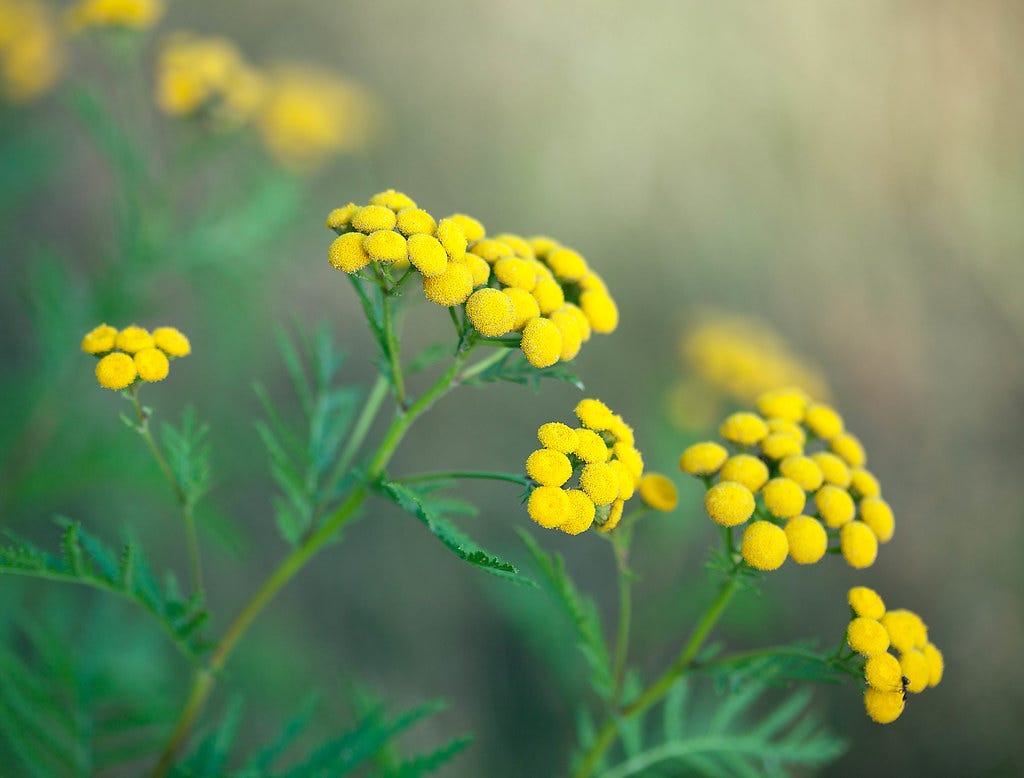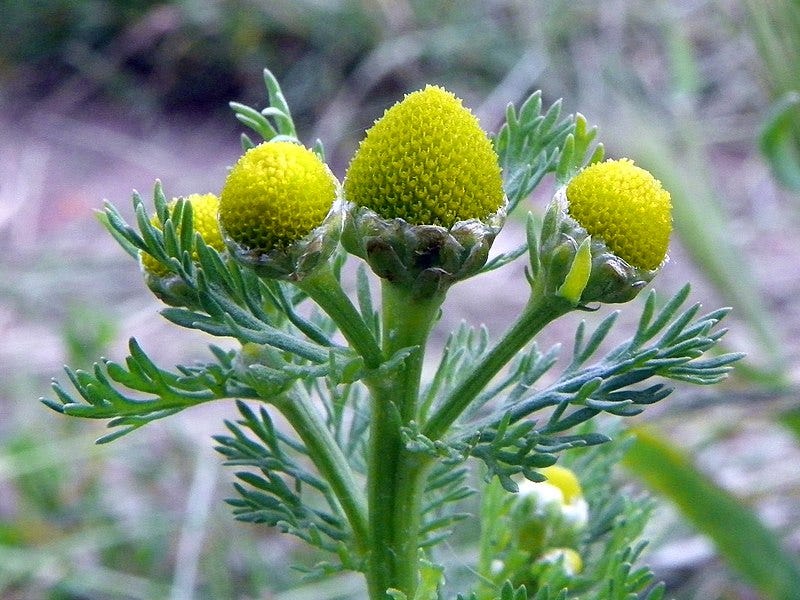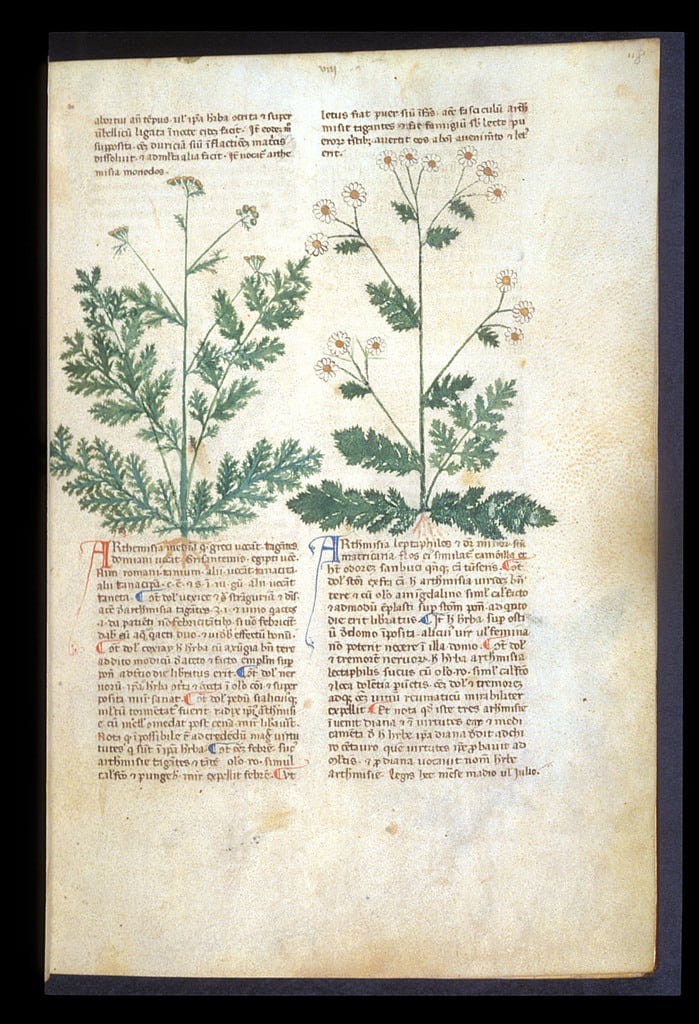ALSO KNOWN AS: golden tansy, garden tansy, Tanacetum vulgare, cow bitter, wrotycz
How to know
A single stalk with alternately branched stems
Feathery leaves
Yellow flowers at the top like tens of spinning discs
They live in groups, growing vegetatively as well as through seed
1’-5’ tall depending on the condition

In the massive Astercaea family, with the daisy, sunflower and dandelion, almost every flower shines a crown of rayed petals, like suns. Asteraceae, indeed, means star. Except for some - among the few that have no ray petals, the tansy plants look like canopies of tiny golden plates. Compared to its kin, the tansy is plain. Their only frill is in their leaves, so deeply lobed with saw-toothed wing fringes, they look like they may soon fly away, carrying off their golden spinning discs and all.
Oily Flowers
Come late summer you can see tansy bloom. But you won’t think much of it. The tansy is just tightly packed petals on a flat plate. Look closely and see how the tiny flowers all bunch together at the flowerhead like the footpads of animals, tucked within miniscule deposits of pollen and nectar. Their inflorescences look like many hands holding plated offerings. This flower structure is called a corymb, and you can see this formation in yarrow and queen Anne’s lace.
Their mythology reflects their pared down, downright awkwardness. No beauty will save them with romantic stories. Their bare heads are bold in their simplicity. Once they bloom they are toxic to cows, pigs, and horses. But like so many young shoots of plants, they are edible at the beginning of the season. But goats and sheep can eat them at any point throughout the summer. Though they don’t want to, the bulletin in Todd County Minnesota recommends training them, so that caprine mouths may be let loose on fields of them as management for the terrific overpopulation of tansy in the Americas. The poisoning of livestock by tansy, however, is rare because they taste the toxins and avoid them. The fact they are toxic doesn’t mean they aren’t terribly useful, though. They were brought to the Americas in the 1600’s as a medicine. Here it the plant was recognized by a range of indigenous groups including the Cherokee and the Cheyenne for its medicinal effect.
And at some point they left gardens, and the folk doctor manuals and spread on their own around North America making cities of themselves.
My ancestry comes most entirely from far Northern and far Eastern Europe. Understanding, as I grew up, the foods of my lineage was understanding the simultaneous pride and shame that were connected to them - and when I reflect upon how these foods taste I understand that much of the flavors connected with them are not necessarily flavors meant for pleasure, but necessity. I think taste is an overrated, fickle thing. Unless a food is poisonous, rancid, or somehow cilantro tastes like soap. Our taste for food can change over time. The taste I know as my ancestors is so often the taste of preservation or transportation: The taste of oil and salt. We don’t taste tansy much in modern day, though if we did we would know how it was used to preserve as well. It’s got a complicated, deadly history since its use as a preservative.
Tanacetum comes from the Greek "Athanasia”, meaning immortal. Vulgare is a word that follows weeds, meaning common. “Common immortality.” If we are looking for something that will last we don’t have to look further than the aromatic roadside to preserve what needs to stay with us in its current state. The most emblematic thing about the tansy is its oil.Oil is used as a preservative because of its antifungal and antimicrobial effects, and its inherent ability to repel water.
A Plant of Taboos
Tansy will grow in impossible places. They can grow in sun or partial shade. It will grow in places that are packed down to the point of stone. It will grow in places that have been upturned - places where the soil has been broken. It will grow in your periphery. This is why it is aggressive in temperate regions, particularly in North America where many urban, rural, and agricultural places alike, undergo much soil disruption. This breaks long held bonds with plants and leaves room for an opportunist. Their root systems are relatively shallow, around two feet deep, but given that they spread, not only through seed, but through rhizomes, they cover the available soil if they are unmanaged.
The Greeks started cultivating the tansy. They must have seen the medicinal and preservative effects because the beautiful Trojan, Ganymede, was given a draught of tansy by Zeus, to make him immortal and the honored cupbearer of the gods. After more than a thousand years cultivated in the gardens of monks and kings, and peasant lots, the tansy was brought to the Americas with settlers who rubbed meat with the plants, and wreathed their dead in their woven stems.
The tansy is truly a plant that sustains in moments of reflection and sacrifice related to the eternal spring holidays of death and resurrection throughout cultures. In Lenten meals, tansy was eaten to calm the stomach - specifically to soothe the gas. And yet, they have been described as somewhat sweet. Tansy treats and favors were given in Medieval Europe to celebrate the coming of the warm months.
In fact it is an insect repellent - of pretty much any insect, from flies, to ticks, mosquitos, and even, it was used to repel bedbugs. It has thujone, which is lethal to insects. Thujone oils are also present in sage plants. Other active oils in the plant are camphor, myrtenol, and Cineole. These work together to protect the plant from being overly browsed in the wild. But they have cardio and neurotoxins that produce convulsions. This plant is a pharmakon in the strongest sense of the word, a medicine, and a poison.
Even as I write this I feel the oils of tansy’s stories sticking to me. I feel I can smell the tansy on the lips of the seamstress whose account of death is recorded by the doctor who was called to where she lived in Boston, far after dark. According to the American Journal of Medical Sciences from 1852. She was described in the medical report as smelling strongly of tansy oil, with bright cheeks in the hours before her death. The oils spread through her like a thick river and she died over the course of three hours. She carried a fetus of around four months and took the oil to live her life without this child. Whether legal or not, supported or not, people will find ways to look for abortions, whether it be in the middle of the Stone Age, a boarding house in Boston, or here. Now.
It has also been used to induce abortion in humans and, incidentally, in cows. However, in smaller doses the tansy plant was also used to promote fertility. It was grown in Charlamegne’s garden, and benedictine monks used tansy to cure worms, reduce fevers, and soothe the stomach. from their ‘physic gardens’. In medieval Europe tansy was known to soothe and warm the Phlegmatic humor common in the winter. While bathing in tansy was said to purify the skin. And in Irish tradition it soothed joint pain.
Tansy knows about being left to the lost, the dead.
All manner of things were wrapped in tansies to keep a little life in them. It was used for funeral services. Corpses were wrapped in tansy to preserve it. The president of Harvard’s coffin was stuffed with tansy flowers, and when the location of his resting place was moved, the flowers had kept their form, around the long aged body. Over time the tansy flower almost became taboo in the colonial period for its association with the dead. Meat was preserved with tansy.
In England the wildlife organization is creating a corridor of plants so that animals and pollinators can have freedom of movement. Tansy is one of those roadside plants that they are using to create this corridor because it attracts a wide range of pollinators to it.
It is also the food for the rare tansy beetle, a lovely and iridescent creature of the Anglican fens.
The tansy beetle is now only found along the banks of the Ouse river in Yorkshire, thanks to the remaining tansy there. The population of tansy itself is lowering in that area. Tansy beetles don’t fly far. With their stout bodies and shield wings, they travel over the top of tansy, and jump in short bursts. Because there is more space between tansy, the beetles are stuck on golden islands by the river.
Fens of England were famously drained, beginning with the Romans in around 500 BC. At one time the entire UK was a forested, wet place that was overflowing with biodiversity. Indeed, it was a rainforest. When we think of rainforests we think of the many layers of tree cover. But we must remember the important waterways and pools at ground level. We also must understand that the wood was probably not overgrown, but opened by fallen trees so sunlight poured in, giving rise to plants like tansy and temperate understory herbs, serving wild boars or cows; bears, or small rabbits. Imagine living in a world where very large animals were wild. How strange and different our stories, how humbled our bodies. For now the greater beasts are greed and plants.
The strong tansy aroma can provide protection as a companion plant for potatoes because it repels potato beetle. It is also a protection against cucurbit pests, so it can be sentinel to cucumbers, pumpkins, squash, and melons, as well as roses.
When the days lengthen and cool in October, the tansy will brown, until they stand like rusted trees, stalk still. Their seeds hide within their old flowers, until time cracks their fibers and lets them fall to earth, or song birds collect their seeds.
The stem is slightly rusted in color and gets more red as the season turns. If these stems are torn up by bare hands, they can create a dermatitis effect like a small curse. Full of aromatic oils - it will redden and blister the skin. So when small draughts of it are delivered, it tastes like sage - as in - it’s oily. This oil is both what makes it toxic and what makes it medicinal and preservative. And yet, studies have shown that the oils in the tansy can be made into biodegradable polymers. The smell is herbal, somewhere between sage and camphor and rosemary, thick and herbal healthful and lethal, like all things with power it has a way of holding, of sticking. Simple, baldheaded, and bold.
Myth for tansy
Text for myth Music: The Tudor Consort, Giovanni Animuccia Missa Victimae Paschale Laudes, “Agnes Dei II”, https://www.classicals.de
Not to be confused with tansy ragwort. It has little yellow ray petals, you know. Though, yes, they are related through the Asterceae family.
Or pineapple weed. We will get to these ones. I grew up observing these small yellow bald heads with wonder. They have similar feathery leaves, and no ray petals. And they don’t grow as tall as the tansy.

Forager Friendly?
Yes. Please understand how to use it once you have harvested it, and use gloves if you are harvesting in large quantities. Do not use this article as your only source. This plant is to be taken seriously. Please do not use this as a medicine. Use it as decoration.
Sources:
https://www.wildlifetrusts.org/wildlife-explorer/wildflowers/tansy
https://www.wildlifetrusts.org/wildlife-explorer/invertebrates/beetles/tansy-beetle
https://www.youtube.com/watch?v=v8-WQUWYg_w
https://www.yorkshiremuseum.org.uk/collections/collections-highlights/tansy-beetles/
https://www.atlasobscura.com/articles/what-is-a-tansy-easter
https://en.wikipedia.org/wiki/River_Ouse,_Yorkshire
https://pmc.ncbi.nlm.nih.gov/articles/PMC10339728/
http://mecklenburghsquaregarden.org.uk/tansy/
https://pmc.ncbi.nlm.nih.gov/articles/PMC9866307/
https://www.co.todd.mn.us/sites/default/files/ditch_ap_inspector/CAIFactSheetCommonTansy2013.pdf
https://www.botanical.com/botanical/mgmh/t/tansy-05.html
https://www.greatfen.org.uk/about-great-fen/heritage/brief-history-great-fen
https://totallywilduk.co.uk/2023/01/05/tansy-tanacetum-vulgare-identification-guide/
https://plants.ces.ncsu.edu/plants/tanacetum-vulgare/
https://theausteritykitchen.com/2020/07/21/bitter-buttons-tansy-and-its-uses-through-history/





